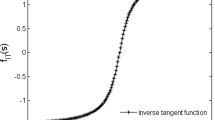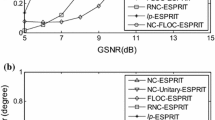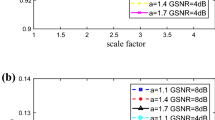Abstract
Noncircular (NC) signals constitute a significant class of signals that are frequently employed in communication systems. In the presence of extremely impulsive noises, determining the direction of these signals can present significant challenges. When the noise tail becomes heavier or the signal-to-noise ratio decreases, existing methods yield poor results. Recently, the authors have developed an empirical characteristic function (ECF)-based MUSIC algorithm. This method is called ECF-MUSIC. Despite its robustness and high precision, it only works with circular signals. This is a direct result of the covariance matrix of the ECF-MUSIC method containing a nonzero relation matrix. In this paper, a novel ECF-based MUSIC is developed to exploit the ECF in DOA estimation of NC signals. Using the CF of the output of the extended array, a new covariance-like matrix is introduced. Then, an analysis of eigen-decomposition is performed to develop a new MUSIC algorithm. Due to the unique properties of ECF, such as its ability to preserve information, this method yields precise results, particularly in the presence of heavy tail noise. Additionally, it doubles the maximum number of detectable sources. The Monte Carlo simulations demonstrate the excellent performance of the method, NC-ECF-MUSIC. This method outperforms existing methods in terms of estimation error and resolution, as demonstrated by these results.

















Similar content being viewed by others
Data Availability Statement
The dataset generated during and/or analyzed during the current study are available from the corresponding author on reasonable request.
References
M. Asghari et al., ECF-MUSIC: an empirical characteristic function based direction of arrival (DOA) estimation in the presence of impulsive noise. Digit. Signal Process. 123, 103440 (2022)
S. Bayat, S. Daei, Separating radar signals from impulsive noise using atomic norm minimization. IEEE Trans. Circuits Syst. II Express Br. 68(6), 2212–2216 (2021)
H. Belkacemi, S. Marcos, Robust subspace-based algorithms for joint angle/Doppler estimation in non-Gaussian clutter. Signal Process. 87(7), 1547–1558 (2007)
P. Chargé, Y. Wang, J. Saillard, A non-circular sources direction finding method using polynomial rooting. Signal Process. 81(8), 1765–1770 (2001)
H. Chen et al., Efficient two-dimensional direction-of-arrival estimation for a mixture of circular and noncircular sources. IEEE Sens. J. 16(8), 2527–2536 (2016)
M.A. Chitre, J.R. Potter, S. Ong, Optimal and near-optimal signal detection in snapping shrimp dominated ambient noise. IEEE J. Ocean. Eng. 31(2), 497–503 (2006)
Y.-H. Choi, Simple direction finding of noncircular signals using the centro-Hermitian property. Digit. Signal Process. 106, 102847 (2020)
Z. Dai et al., Computational efficient two-dimension doa estimation for incoherently distributed noncircular sources with automatic pairing. IEEE Access 5, 20249–20259 (2017)
H. Gao et al., Monostatic MIMO radar direction finding in impulse noise. Digit. Signal Process. 117, 103198 (2021)
P. Gounon, C. Adnet, J. Galy, Localization angulaire de signaux non circulaires. Traitement du Signal 15, 17–23 (1998)
Haardt, M. and F. Romer, Enhancements of unitary ESPRIT for non-circular sources. in 2004 IEEE International Conference on Acoustics, Speech, and Signal Processing. 2004.
G. Hastie et al., Effects of impulsive noise on marine mammals: investigating range-dependent risk. Ecol. Appl. 29, e01906 (2019)
Z. Huang et al., 2-D DOA estimation for incoherently distributed sources considering mixed circular and noncircular signals in massive MIMO system. IEEE Access 7, 106900–106911 (2019)
Z. Jinfeng, Q. Tianshuang, A novel covariation based noncircular sources direction finding method under impulsive noise environments. Signal Process. 98, 252–262 (2014)
R.J. Kozick, B.M. Sadler, Maximum-likelihood array processing in non-Gaussian noise with Gaussian mixtures. IEEE Trans. Signal Process. 48(12), 3520–3535 (2000)
S. Li et al., DOA estimation based on sparse representation of the fractional lower order statistics in impulsive noise. IEEE/CAA Journal of Automatica Sinica 5(4), 860–868 (2018)
L. Liang et al., Direction of arrival estimation with off-grid target based on sparse reconstruction in impulsive noise. J. Low Freq. Noise Vib. Act. Control 40, 315–331 (2020)
D. Liu et al., A novel reduced-dimensional beamspace unitary ESPRIT algorithm for monostatic MIMO radar. Digit. Signal Process. 114, 103027 (2021)
S. Luan et al., Generalized covariance-based ESPRIT-like solution to direction of arrival estimation for strictly non-circular signals under alpha-stable distributed noise. Digit. Signal Process. 118, 103214 (2021)
S. Luan et al., Generalized covariance for non-Gaussian signal processing and GC-MUSIC under alpha-stable distributed noise. Digit. Signal Process. 110, 102923 (2021)
N.D. Merchant et al., Impulsive noise pollution in the Northeast Atlantic: reported activity during 2015–2017. Mar. Pollut. Bull. 152, 110951 (2020)
A. Naghavi et al., A sequential MUSIC algorithm for scatterers detection in SAR tomography enhanced by a robust covariance estimator. Digital Signal Process. 128, 103621 (2022)
B. Picinbono, On circularity. IEEE Trans. Signal Process. 42(12), 3473–3482 (1994)
P.J. Schreier, L. Scharf, Statistical Signal Processing of Complex-Valued Data- The Theory of Improper and Noncircular Signals. Statistical Signal Processing of Complex-Valued Data: The Theory of Improper and Noncircular Signals, (2010), p. 1–309.
L. Shengyang et al., BNC-based projection approximation subspace tracking under impulsive noise. IET Radar Sonar Navig. 11, 1055–1061 (2017)
J. Steinwandt, F. Roemer, M. Haardt, Sparsity-based direction-of-arrival estimation for strictly non-circular sources. in 2016 IEEE International Conference on Acoustics, Speech and Signal Processing (ICASSP), 2016.
J. Steinwandt et al., Sparsity-aware direction finding for strictly non-circular sources based on rank minimization. in 2016 IEEE Sensor Array and Multichannel Signal Processing Workshop (SAM). 2016.
A. Swami, B. Sadler, TDE, DOA and related parameter estimation problems in impulsive noise. in Proceedings of the IEEE Signal Processing Workshop on Higher-Order Statistics, 1997.
W. Tan et al., Direction-of-arrival of strictly non-circular sources based on weighted mixed-norm minimization. EURASIP Journal on Wireless Communications and Networking, 2018. 2018.
Y.-N. Tian et al., Group sparse underwater acoustic channel estimation with impulsive noise: Simulation results based on Arctic ice cracking noise. J. Acoust. Soc. Am. 146(4), 2482–2491 (2019)
P. Tsakalides, C.L. Nikias, The robust covariation-based MUSIC (ROC-MUSIC) algorithm for bearing estimation in impulsive noise environments. IEEE Trans. Signal Process. 44(7), 1623–1633 (1996)
L. Wan et al., DOA estimation for coherently distributed sources considering circular and noncircular signals in massive MIMO systems. IEEE Syst. J. 11(1), 41–49 (2017)
B. Wen, Y. Wei, Z. Lu, Sea clutter suppression and target detection algorithm of marine radar image sequence based on spatio-temporal domain joint filtering. Entropy 24, 250 (2022)
B. Yang et al., Direction-of-arrival estimation of strictly noncircular signal by maximum likelihood based on moving array. IEEE Commun. Lett. 23(6), 1045–1049 (2019)
X. Yang et al., Central DOA estimation of incoherently distributed noncircular sources with cross-correlation matrix. Circuits Syst. Signal Process. 2015. 34.
J. Yin et al., ML-based single-step estimation of the locations of strictly noncircular sources. Digit. Signal Process. 69, 224–236 (2017)
J. Yu, Empirical characteristic function estimation and its applications. Economet. Rev. 23(2), 93–123 (2004)
Z. Yuan et al., Characteristics of snapping shrimp noise in the northeastern East China Sea. J. Acoust. Soc. Am. 141(5), 3525–3526 (2017)
W. Zeng, H.C. So, L. Huang, lp-MUSIC: robust direction-of-arrival estimator for impulsive noise environments. IEEE Trans. Signal Process. 61(17), 4296–4308 (2013)
D. Zha, T. Qiu, Direction finding in non-Gaussian impulsive noise environments. Digit. Signal Process. 17, 451–465 (2007)
J. Zhang, T. Qiu, The fractional lower order moments based ESPRIT algorithm for noncircular signals in impulsive noise environments. Wirel. Pers. Commun. 96(2), 1673–1690 (2017)
J. Zhang, T. Qiu, S. Luan, An efficient real-valued sparse Bayesian learning for non-circular signal’s DOA estimation in the presence of impulsive noise. Digital Signal Process. 106, 102838 (2020)
J. Zhang et al., Bounded non-linear covariance based ESPRIT method for noncircular signals in presence of impulsive noise. Digit. Signal Process. 87, 104–111 (2019)
J. Zhang et al., A novel correntropy based DOA estimation algorithm in impulsive noise environments. Signal Process. 104, 346–357 (2014)
X. Zhang et al., DOA Estimation of mixed circular and noncircular sources using nonuniform linear array. IEEE Transactions on Aerospace and Electronic Systems, (2022), p. 1–1.
A. Zoubir, P. Chargé, Y. Wang, Non circular sources localization with ESPRIT. in Proc. European Conference on Wireless Technology (ECWT 2003). 2003.
Author information
Authors and Affiliations
Corresponding author
Ethics declarations
Conflict of interest
No funding was received to assist with the preparation of this manuscript.
Additional information
Publisher's Note
Springer Nature remains neutral with regard to jurisdictional claims in published maps and institutional affiliations.
Rights and permissions
Springer Nature or its licensor (e.g. a society or other partner) holds exclusive rights to this article under a publishing agreement with the author(s) or other rightsholder(s); author self-archiving of the accepted manuscript version of this article is solely governed by the terms of such publishing agreement and applicable law.
About this article
Cite this article
Asghari, M., Zareinejad, M., Rezaei, S.M. et al. DOA Estimation of Noncircular Signals Under Impulsive Noise Using a Novel Empirical Characteristic Function-Based MUSIC. Circuits Syst Signal Process 42, 3706–3743 (2023). https://doi.org/10.1007/s00034-022-02289-9
Received:
Revised:
Accepted:
Published:
Issue Date:
DOI: https://doi.org/10.1007/s00034-022-02289-9




